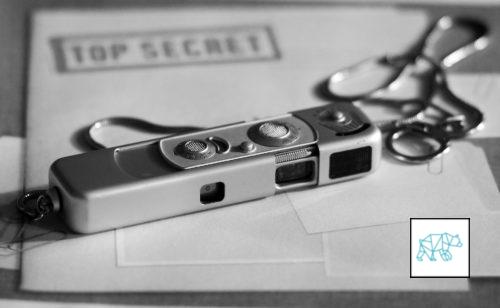
28 Sep Writing a trading plan — part 1
Writing a trading plan
Part 1
One of the best sources out there for learning anything about trading is definitely without a doubt; Investopedia. So many highly professional contributors and knowledge to be found there. That is also where I found this article on ‘Building the Perfect Master Plan’ by Matt Blackman.
So thanks to Matt and thanks Investopedia.
Part of a series
This is only the first part of probably two posts about ‘writing a trading plan’. Not sure how many parts it will have because that all depends on how much work each part will take to write.
First get this through your thick skull
But before we start I’d like to say the following. Yes, I am trading a very small account and some may laugh. That’s OK. This is my journey and I believe that I need to follow my own path and aim for consistency before I risk too much. It’s not that I can’t lose thousands of dollars, but why would I risk it? At this point I am getting more lucky than actually being good. I understand this and I accept this. We have to be honest with ourselves and acknowledge when it’s an ability or just sheer luck. So many brag about their gains, but you never hear them on their losses. Not me. I strive to be good at this. I don’t gamble. I don’t believe in luck. I believe in my plan. And the only way to do this is to be honest. I have no benefit in lying to you because that means I’d be lying to myself. And that is what you will read here. So go on. Mock me. Or… read on and hopefully I contribute something to your journey in becoming a trader.
DISCLAIMER
Here it goes…
Writing a trading plan is like writing a business plan. After all, don’t you think that trading is a business? I hope you don’t think it’s gambling. Even though there is something to be said about gambling being a business as well. Of course I got to see the casino business from up close in Macau and pondered their strategies and how they play with our emotions. Read that article here. There is also something to be said about an individual treating gambling as a business. Look at all the professional poker players. Do you actually think that playing poker is considered gambling to them? If you take the time to master anything it is not just about gambling anymore. It is about beating the odds. Increasing the probability of winning and keeping your losses short. This all, my friend, starts with a business plan.
Skill assessment
Technical Analysis
I have filled my brain with knowledge on technical indicators like:
- Bollinger bands
- Moving averages
- Chart patterns
- Japanese candlesticks
- Volume indicators
Don’t know what these are? Google them!
Fundamental Analysis
I’ve learned about the market I want to trade which is the WTI crude oil market. I dove into the fundamentals of it to understand which players there are. What fundamentals influence this market and you can read it all here:
- What drives oil prices? The balance of oil inventories.
- What drives oil prices? The demand side. OECD vs Non-OECD.
- What drives oil prices? OPEC vs Non-OPEC.
- What drives oil prices? Spot prices.
- What drives oil? Financial markets.
- Also the IMF working paper: oil prices and the world economy.
Real-life experience
I started off with trading a demo account for a while before moving on to a live account. Read all about it here. What I gathered from that is that you have to be active in analyzing your trades. Really understand them to find out what you are doing right and what not. All these things have helped me to get a better understanding of how my trading plan should be. My original trading plan was. ‘You got this, just trade’. Needless to say my arrogance was slammed down hard. Having said that I do think it’s crucial to dabble your feet a bit first and see if you like the temperature. Then dive in and see if you drown. I ain’t drowning yet, my brother. If I do, I’ll drown with pride. Having known I’ve given it my all, my body will drift away in the current with tiny air bubbles still coming from my nose. And I’ll disappear into the green darkness of the water. Never to be seen again. Well, until I get stuck in some dam or wash up on some shore. Too much?!
Mental Preparation
In this part Matt suggest to gauge your mental state for the day. ‘Did you sleep well?’, Do you feel up to the challenge?’, and it goes on to say that ‘if you are not emotionally and psychologically ready to do battle in the markets, it is better to take the day off.’ It also goes on to suggest that it is best to have a ‘market mantra’. This is something that I personally really believe in. Neurolinguistic programming, or NLP. Henry Ford’s famous quote ‘Whether you think you can or you can’t, you’re right’ applies here. The thing, though, is that you can direct your thoughts with such a mantra. So here’s mine for when I start my trading day:
“I will focus on managing my risk and thus losses more than taking profits. I am not the master of the market, but I am the master of myself. I will trade my plan and my plan only. Regardless of the outcome, profit or loss, a perfectly executed trade is the ultimate goal here. Profit/Loss is merely a scorecard at the end of the day to gauge if you are on the right track.”
Now, I’m sure that this market mantra will evolve as I evolve as a trader. I might add things or shorten it. We’ll see, won’t we? There is another thing I do for mental preparation though and that is MUSIC. Ooohh me love me some music! The genre of music that I like to listen to is probably not something that everyone will like I think, but it’s called Minimal Techno. There’s something about the repetitiveness of the beats that is so alluring. It kind of puts me in a trance and I can focus on trading more. I have a standing desk to combine with this and often times I find myself dancing in front of my desk looking at charts. Kinda the way a DJ stands in front of his equipment and then let’s go of the switches and buttons during a climax (of the song) to do a little twirl of joy on the melodious beats. Do whatever works for you. This is my weird way. You find your own and don’t you dare steal mine!
Set Risk Level
In this part we will have to think about what level of risk I am willing to take. How many percent of my account am I to risk on one day. Meaning after losing how much money will I call it quits for the day. Your trading style and and risk tolerance is what will define the level of risk for you. I base mine on the results of my trading history provided by my broker in the form of an account statement.
Balance chart
This is how my balance chart looks like for the last month. From it we can see the following statistics:
- 109 trades taken
- 88 were winners (about 80%)
- 21 were losers (about 20%)
- the winners made an average profit of EUR 1.34 and the losers made an average loss of EUR 4.22
- Gross profit EUR 118, gross loss EUR 88.69
- Total net profit EUR 29.31
- My average consecutive wins are 6.36 and losses 1.62
No risk, no glory.
So for every 10 trades I make I lose on 2 trades. If my Take Profit is 2 Euros and my Stop Loss is at 2 Euros as well that would mean I make 8 x 2 = 16, 2 x 2 is 4, 16 — 4 = 12 Euros. I’d say those are good odds. However, to be fair… some of these trades I leave open till they turn a profit. If I take that into consideration the balance might be 60% winning and 40% losing. Just to play it safe. That would mean 6 x 2 = 12 Euros, 4 x 2 is 8 Euros, leaving 4 Euros profit. Which doesn’t sound as great as before but hey… still a profit. I do seem to be getting the direction right most of the time, but my account gets wiped out because I don’t cut my losses short thinking price action will turn around and go in my favor. Applying such a tactic on a normal account is very risky, doing it on a leveraged account is even more risky. Read here more on how leveraging works on my account.
No risk, no glory.
Now that I have a better understanding of my trades it’s time to set daily, weekly, and monthly limitations. So how much am I allowed to lose on a day, in a week, or in a month? The article suggest using 1% to 5% of your account size as risk. To answer this I would first have to determine how much I will put into my trading account to start my second run at trading live. At first I did EUR500,- but in increments of EUR100,- each time. This didn’t work before because of the huge drawdown of trades losing in combination with the leverage, I would get stopped out by a margin call (not having sufficient funds left in my account to keep my positions open) and lose most of my account size. This time around I am thinking of doing 200 Euros at once, but let’s look at the math first.
Doing the math (BORINGGG!)
If I only put 100 Euros in my account, I calculated how many trades I can have go against me (I know the positions open might not make much sense but this is just an example). Wanna know more about leverage? Read this article.
- Current price is at 50
- 10 barrels long at 51 is 1 Euros loss per barrel = 10 Euros loss
- 10 barrels long at 52 is 2 Euros loss per barrel = 20 Euros loss
- 10 barrels short at 49 is 1 Euros loss per barrel = 10 Euros loss
- 10 barrels at 2 Euros loss = 20 Euros loss
- Total of 60 Euros in losses.
The initial margin of these will be around 40 meaning that I used 40 Euros out of my account which had 100 Euros in it to start with, Then if I divide the intial margin with the equity which at this point is 40 as well (100 account minus 60 loss) means I have 100% margin level left. Which at this point means I can’t open new positions anymore. As soon as I hit the 100% margin level threshold I can’t open positions. Then when I hit the 50% mark my open losing positions are closed one by one to keep me over the 50% mark.
Obviously, I can have more positions open with less losses to still keep me afloat. However, I will use 2 losing trades as the maximum I will have open at any given moment. Until they hit the stop loss of 2 Euros and take me out.
In conclusion
I believe I am being very conservative with the example above. Also, the example given is that for a 100 Euro account, but I will fund mine with 200 Euros. So if I use the 1% to 5% risk margin of my account that would mean I can lose anywhere between 2 to 10 Euros on a day. My daily risk is at the 6 Euro level. My weekly risk I will put at 12 Euros. Monthly at 24.
Set Goals
I have divided my main goal of becoming a successful trader into subdivisions. It all starts with the first step. These are the subdivisions of my goal:
- Turn 200 Euros into 500 Euros using micro lot positions (in my case of WTI crude oil that means 10 barrels per position) with a leverage of 50:1.
- After hitting the 500 mark I will up my position size from 10 to 100 barrels with the same leverage size. The goal now is to turn it into 1000 Euros.
- Now we can get serious. I believe that at this point I am doing more right than wrong and am willing to risk more. Stay tuned to follow my progress.
I will have to adjust my goals periodically as I go along, but I think that this is a good starting point.
Risk/Reward ratio
On any given trade I will have a stop loss of 2 Euros. I don’t set take profits because I’d like to see how they do before I close them. Sometimes I let them ride. Sometimes I close them soon because I get the feeling the tide is about to turn. I know that this probably doesn’t make much sense to some but if you remember that I am about 80% right I will still make money. My trading style is considered to be that of a scalper, because I take a lot of positions in a day. I just want to protect my small profits by keeping a stop loss on any trades that go against me. We’ll see if this works and if I’m doing something right. If not, it’s back to the drawing board for me.
Calling it quits for the day
When you start making money in the markets it is easy to lose your head. You make some money, start thinking you’re the man. Getting overconfident and start making mistakes. This is why it is also good to have a profit goal for the day besides having a risk level. At this level I believe that If I make 15 Euros a day I should call it quits. Remember, the name of the game is: ‘protect your money’. Having a good day. Quit while you’re ahead.
To be continued…
Thank you
As always, thank you for reading. Let me know down below how you go about writing your trading plan. I don’t bite. Well, sometimes… but that’s none of your business! 🙂





No Comments